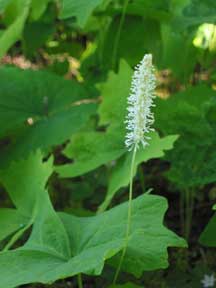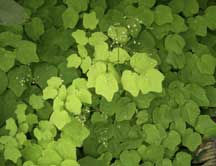 |
Previous Issues |
| Cedar Mill Community Website |
|
| About Cedar Mill News |
|
||||||
| Volume 4, Issue 11 | November
2006
|
|||||
The Nature of Cedar Mill
|
 |
| Inside-out flower |
Dull Oregon-grape,
Mahonia nervosa, usually grows to about 3 feet tall and is often
seen as an understory shrub that dominates the forest floor. The leaflets
of this species have 3 or more nerves that originate at the base of the leaf,
thus nervosa. Both species have deep yellow sprays of flowers that give way
to purplish berries that ripen in mid-summer. Native Americans ate the berries
of these two shrubs and used the yellow roots for a source of yellow
dye for some of the ornamentation that they used. The berries also make wonderful
jelly, as long as plenty of sugar is used.
(Note that the common names of these two shrubs are hyphenated, indicating
that they are not true members of the grape family. Many other common
names are similarly hyphenated or compound for the same reason, for
example Douglas-fir, Indian-plum, western redcedar, and poison-oak.)
 |
| Vanilla leaf – Achlys triphylla |
The next genus is Achlys (pronounced AY-klis) and has only one species in our area: vanillaleaf or deerfoot, Achlys triphylla, which is very common throughout the West Hills. Achlys was the Greek goddess of night or obscurity and the name for this genus is thought to refer to the inconspicuous flowers. This is a diminutive forest herb, averaging about eight inches tall, that has three leaves (tri + phylla) and a small spike of creamy white flowers on a separate stem. Native Americans hung bundles of stems and leaves to ward off mosquitoes and other insects as well as to perfume the air with the scent of vanilla.
 |
| Vancouveria hexandra "duck-feet" |
The last genus in our list is Vancouveria and is named for Captain George Vancouver, who explored the Northwest coast in the late 1700s. Vancouveria hexandra, or inside-out-flower, is another herb that you’ll find carpeting the Douglas-fir forest floor in the West Hills. This flower is aptly named, for when the plant is in full bloom it appears as if each small, pendulous flower has been turned inside out, with the white petals curved back away from the six (thus the name, ‘hexandra’), fully exposed stamens. The leaves of this plant look like a duck’s footprint, and usually grow three to a stem, though there may be several leaf stems arising from a single primary stem.
…and I’ll bet you thought Latin wasn’t fun!
Cedar Mill Business Association
Published monthly by Cedar Mill Advertising & Design
Publisher/Editor:Virginia
Bruce
503-629-5799
12110 NW West Rd
Portland, OR 97229